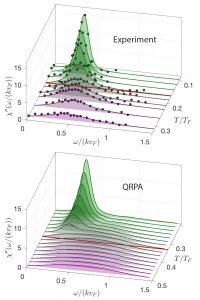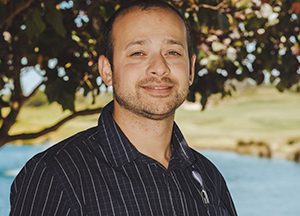A Swinburne University of Technology study published this week examines the propagation of energy as sound waves in a quantum gas, revealing for the first time strong variations in the nature of the sound wave as a function of temperature.
At low energies, this energy travels via the collective movement of many particles moving in sync – essentially, as sound waves –quantified using quasiparticles known as phonons.
Below the superfluid transition temperature Tc these sound waves in a unitary Fermi gas can propagate without collisions and are driven by ripples in the phase of the superfluid order parameter (wave-function)—this mode is known as the Bogoliubov-Anderson (BA) phonon.
Above Tc, the sound waves become more strongly-damped, and collisions play a dominant role.
- <Tc In the colder, superfluid mode, damping is dominated by collisions with thermally excited quasiparticles and is well described by (QRPA) theory
- >Tc Above the transition temperature, the strongly-damped mode occurs at the crossover between collisionless hydrodynamic regimes.
- >>Tc At even higher temperatures, collective propagation of sound-wave vanishes, and excitation is dominated by the energy of individual particles.
Strong similarities were identified in the temperature dependence of sound in the unitary Fermi gas and the behaviour of phonons in liquid helium, which was one of the first superfluids identified historically.
This study provides quantitative benchmarks for dynamical theories of strongly-correlated fermions.
More about the study
The ultracold atomic gases formed and studied in Prof Chris Vale’s lab at Swinburne allow very precise tuning of interactions between atoms.
“We cooled and confined a highly dilute gas of Li6 atoms, realising a unitary Fermi gas, which exhibits the strongest interactions allowed by quantum mechanics with a contact potential,” explains Prof Vale.
In a unitary gas, elastic collisions become resonant and the thermodynamic properties of the gas become universal functions of the temperature and density. Unitary Fermi gases allow precise testing of theories of interacting fermions.
The team then studied excitations in the gas above and below the superfluid phase transition Tc using two-photon Bragg spectroscopy.
“We measured excitation spectra at a momentum of approximately half the Fermi momentum, both above and below the superfluid critical temperature Tc,” explains study author Dr Carlos Kuhn.
Two, focused laser pulses (approx 1.2 milliseconds in duration) intersecting within the gas create a periodic perturbation for the lithium atoms.
Immediately after the twin laser pulse, the confining optical trap is switched off and the momentum of atoms is measured after 4 milliseconds of expansion, and can be mapped as a function of laser frequency.
The finite duration and size of the Bragg beams lead to a Fourier-limited spectral resolution of approximately 1:25 kHz FWHM which is well below the typical Fermi energies, EF 11 kHz, used in the experiments.
The study
High Frequency Sound in a Unitary Fermi Gas was published in Physical Review Letters (PRL) in March 2020. (DOI 10.1103/physrevlett.124.150401)
The study was featured in an editorial article: Strumming a Strongly Interacting Fermi Gas
As well as support from the Australian Research Council the authors thank M. Zwierlein, Y. Castin and H. Hu for stimulating discussions and J. Denier for assistance on initial experiments, and acknowledge financial support from the Independent Research Fund of Denmark.
Ultracold studies at FLEET
The study of many-body quantum systems with strong inter-particle interactions is of great interest for the understanding of novel materials.
Within FLEET, Chris Vale studies topological phenomena in 2D gases of ultracold fermionic atoms, investigating cold atom implementations of Floquet topological superfluidity, nonequilibrium enhancements to the superconducting critical temperature and new forms of topological matter based on optically induced spin-orbit coupling in 2D atomic gases, in Research Theme 3.
FLEET’s research theme 3 studies systems that are temporarily driven out of thermal equilibrium to investigate the qualitatively different physics displayed and new capabilities for dynamically controlling their behaviour.
Chris leads the study of quantum gases at Swinburne University of Technology. In these collections of atoms cooled to only 100 nano-Kelvins above Absolute Zero, behaviours that are usually only found at the microscopic level become prominent at the macroscopic level.
The team’s study of Fermi gases confined to 2D tests new paradigms for dissipationless transport in topological and non-equilibrium quantum matter synthesised from ultracold atoms.
 Chris is one of almost a hundred researchers at FLEET, all motivated by one grand challenge: to reduce the energy used in information and communication technology (ICT), which already accounts for at least 8% of global electricity use, and is doubling every decade.
Chris is one of almost a hundred researchers at FLEET, all motivated by one grand challenge: to reduce the energy used in information and communication technology (ICT), which already accounts for at least 8% of global electricity use, and is doubling every decade.
More information
- Contact Prof Chris Vale cvale@swin.edu.au
- Connect @FLEETCentre
- Visit org.au
- Discover ultra-low temperature physics at Swinburne
- Watch Future solutions to computation energy use





